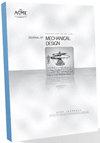在设计中考虑机器学习的预测误差
IF 3
3区 工程技术
Q2 ENGINEERING, MECHANICAL
引用次数: 0
摘要
机器学习在机械设计领域的地位日益突出,它提供了具有成本效益的替代模型,以取代计算成本高昂的模型。然而,这些模型的准确性仍然令人担忧,尤其是在应用于安全关键型产品时。为了应对这一挑战,本研究探讨了通过将认识不确定性纳入代用模型,同时管理输入变量的不确定性来解释模型预测误差的方法。本文阐明了在使用从无噪声训练数据中得出的代用模型时,建立认识不确定性和可知不确定性耦合模型的关键方面。具体来说,研究集中于通过开发基于最可能点概念的数值方法,量化机械设计中耦合不确定性的影响。这种方法尤其适用于机械部件设计,因为在这种设计中,预防故障至关重要,而故障发生的概率很低。它适用于以概率分布为特征的设计问题,概率分布控制着模型输入和预测中的不确定性和认识不确定性。以轴和梁的设计为例,演示了所提出的方法。结果表明,该方法在量化和减轻设计过程中耦合不确定性的影响方面非常有效。本文章由计算机程序翻译,如有差异,请以英文原文为准。
Accounting for Machine Learning Prediction Errors in Design
Machine learning is gaining prominence in mechanical design, offering cost-effective surrogate models to replace computationally expensive models. Nevertheless, concerns persist regarding the accuracy of these models, especially when applied to safety-critical products. To address this challenge, this study investigates methods to account for model prediction errors by incorporating epistemic uncertainty within surrogate models while managing aleatory uncertainty in input variables. The paper clarifies key aspects of modeling coupled epistemic and aleatory uncertainty when using surrogate models derived from noise-free training data. Specifically, the study concentrates on quantifying the impacts of coupled uncertainty in mechanical design through the development of numerical methods based on the concept of the most probable point. This method is particularly relevant for mechanical component design, where failure prevention holds paramount importance, and the probability of failure is low. It is applicable to design problems characterized by probability distributions governing aleatory and epistemic uncertainties in model inputs and predictions. The proposed method is demonstrated using shaft and beam designs as two illustrative examples. The results demonstrate the method's effectiveness in quantifying and mitigating the influence of coupled uncertainty in the design process.
求助全文
通过发布文献求助,成功后即可免费获取论文全文。
去求助
来源期刊

Journal of Mechanical Design
工程技术-工程:机械
CiteScore
8.00
自引率
18.20%
发文量
139
审稿时长
3.9 months
期刊介绍:
The Journal of Mechanical Design (JMD) serves the broad design community as the venue for scholarly, archival research in all aspects of the design activity with emphasis on design synthesis. JMD has traditionally served the ASME Design Engineering Division and its technical committees, but it welcomes contributions from all areas of design with emphasis on synthesis. JMD communicates original contributions, primarily in the form of research articles of considerable depth, but also technical briefs, design innovation papers, book reviews, and editorials.
Scope: The Journal of Mechanical Design (JMD) serves the broad design community as the venue for scholarly, archival research in all aspects of the design activity with emphasis on design synthesis. JMD has traditionally served the ASME Design Engineering Division and its technical committees, but it welcomes contributions from all areas of design with emphasis on synthesis. JMD communicates original contributions, primarily in the form of research articles of considerable depth, but also technical briefs, design innovation papers, book reviews, and editorials.
 求助内容:
求助内容: 应助结果提醒方式:
应助结果提醒方式:


